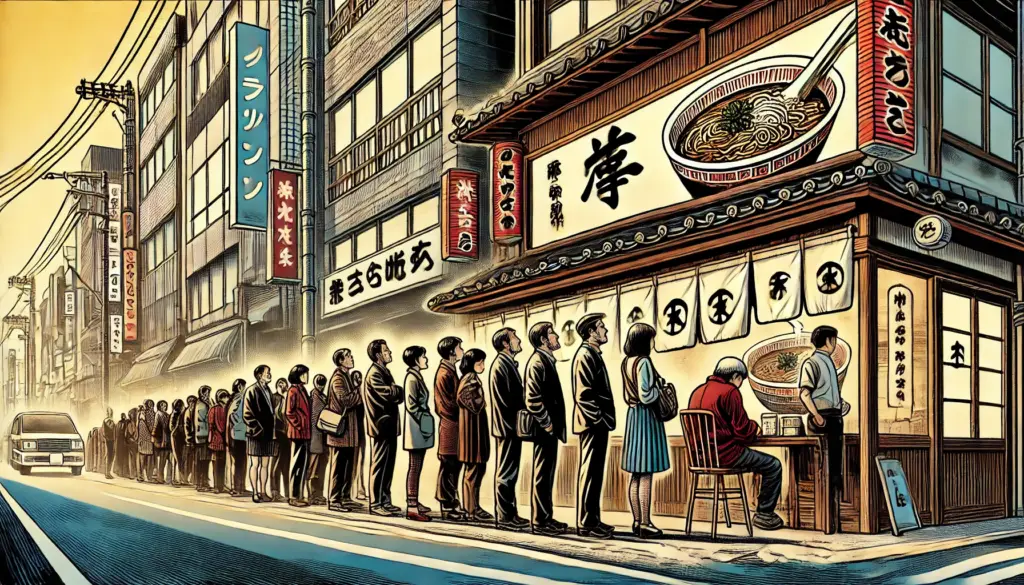
From the outside, it may seem puzzling: why would dozens of people willingly stand in line, sometimes for over an hour, just to eat a bowl of noodles? In Japan, especially in major cities like Tokyo, Osaka, or Fukuoka, long lines in front of ramen shops are a common sight—and they’re not only for tourists. In fact, most of those patiently waiting are Japanese locals. But what drives this phenomenon?
This article explores the psychology behind ramen line culture, the unwavering dedication of ramen fans, and what it reveals about broader Japanese social behaviors. 🍜
🍥 The Ramen Queue: A Symbol of Prestige?
In Japan, “gyouretsu no dekiru mise” (行列のできる店) is more than just a phrase—it’s a badge of honor. A restaurant that draws long lines is automatically perceived as popular and high-quality. This creates a feedback loop: the longer the line, the more desirable the place becomes.
Unlike many Western cultures where long waits are seen as inefficient or frustrating, in Japan, queuing for food is considered a norm—and sometimes even an experience in itself. There’s an unspoken understanding that if people are waiting, it must be worth it.
🧠 The Psychology of Ramen Devotion
Ramen is not just food in Japan. It’s a passion, a subculture, and for some, a way of life. Many “ramen otaku” (ラーメンオタク)—hardcore ramen lovers—spend weekends traveling across prefectures to try limited-edition bowls or newly opened shops. Entire forums, YouTube channels, and apps are dedicated to reviewing ramen shops, cataloging flavor profiles, and analyzing noodle thickness.
These fans don’t mind queuing, because the wait adds to the ritual. It builds anticipation and allows for social bonding with fellow enthusiasts. Some even argue that the wait allows one’s hunger to peak at the perfect level for full appreciation.
🕒 How Long Are Fans Willing to Wait?
Surveys and street interviews conducted in Japan suggest that:
- 30 minutes is considered “reasonable” for a popular shop.
- 60 minutes is “normal” for legendary or newly opened ramen spots.
- Over 90 minutes? Only the truly dedicated endure this, often for once-in-a-lifetime or limited-release bowls.
Remarkably, in 2023, some Tokyo ramen shops had lines forming two hours before opening, with customers bringing stools, umbrellas, and even portable fans.
These aren’t just lines—they’re pilgrimages. And ramen lovers seem to take pride in surviving the wait, even sharing their experience online as a badge of honor.
🔥 Social Media and Hype Culture
Instagram and TikTok have also played a major role. A single viral post can bring hundreds to a once-sleepy ramen joint. Influencers and food vloggers contribute to the hype, and shops often limit quantities (e.g. “only 30 bowls a day”) to maintain exclusivity and buzz.
This leads to a form of FOMO (fear of missing out) among ramen fans. Many queue not only for the taste but also to be among the first to report on the latest bowl in town.
🧍♂️Queuing Culture in Japan: More Than Ramen
Japan’s relationship with queues is unique. Whether it’s for limited-edition merchandise, seasonal sweets, or Pokémon store openings, the Japanese are famous for their orderly, silent, and patient queuing behavior. Ramen lines are just a visible extension of this deeply embedded cultural norm.
In a society that values harmony, fairness, and shared experience, lining up is not just tolerated—it’s respected. Skipping the line or cutting in would be socially unacceptable.
🍜 The Ritual of the Bowl
For many, the moment they step into a ramen shop after a long wait feels almost ceremonial. The contrast between the cold street and the steaming bowl, the sounds of slurping, the concentrated expressions—it all contributes to what fans describe as a “sacred moment.”
Some ramen fanatics even describe their experience in spiritual terms, saying things like “the broth healed my soul” or “I felt reborn after this bowl.” It might sound exaggerated, but for many, ramen provides a profound emotional connection.
📱 Is Technology Changing the Queue?
In recent years, a few ramen shops have introduced reservation systems, numbered tickets, or mobile apps to reduce crowding and stress. But interestingly, many customers prefer the old-fashioned line. It proves the shop’s worth and builds trust—there’s no “marketing trick,” just visible popularity.
However, some younger customers and foreign visitors have voiced frustration with the wait system, especially during peak lunch hours. This tension between tradition and convenience is slowly reshaping the ramen landscape.
💡 Final Thoughts: More Than Just Noodles
So, why do Japanese people line up so passionately for ramen?
Because it’s not just food—it’s culture, pride, community, and personal identity. The wait is not a barrier, but a part of the experience, reinforcing the idea that good things are worth waiting for.
Next time you see a long line outside a ramen shop in Japan, don’t scoff. Step in line, embrace the culture, and savor every slurp when your turn finally comes. Just remember to bring an umbrella and a little patience. 😉



















































